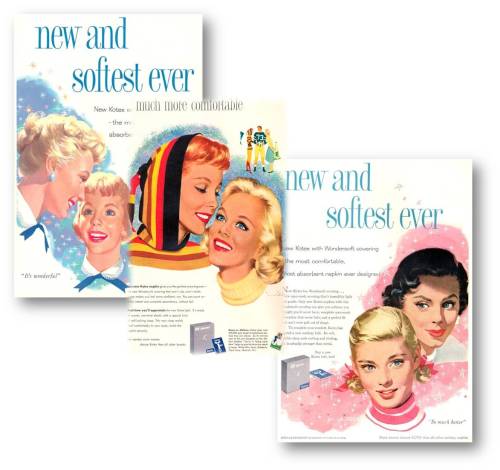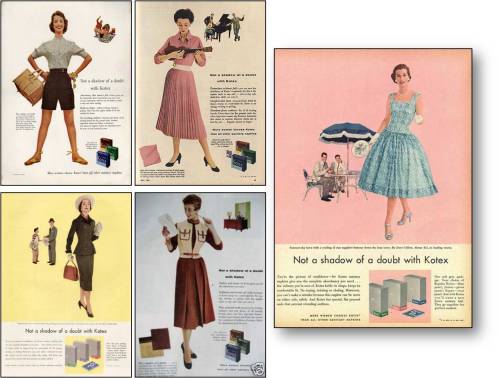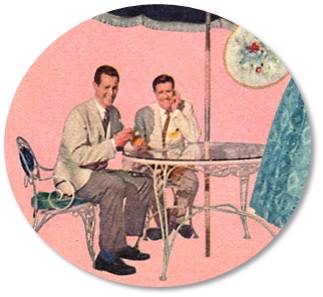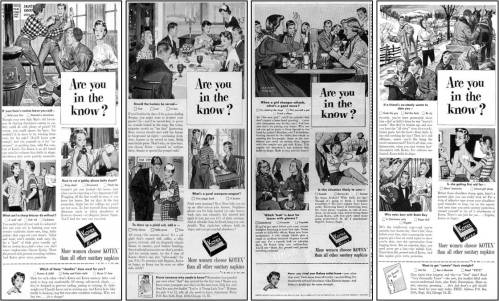In 1950s, Kotex ran a series of print ads with a slogan “Not a shadow of a doubt with Kotex” that centered on building women’s self confidence with Kotex, which was historically relevant considering the period these ads were printed in.
During WWII, men were forced to leave behind their jobs, while women had to step up to fill in the gaps in the workforce. As a result, in the post-war era of 1950s, the traditional roles of women (as housewives and mothers) shifted, as more women joined the workforce. However, although the proportion of working wives tripled from 1940, the average women’s salaries were only less than 60% of men’s – and indication of how society still perceived that women were considered inferior to men in the workforce.
As such, many women began to feel insecure of holding the responsibilities that men once took up. Kotex advertisements tapped on this insecurity and portrayed advertisements that might be seen as a disaffiliation to the present societal view towards women.
In this series, the clothes worn are an indication of the cultures of that time. The figure of women is always prominently placed at the foreground, with all of them dressed fashionably in different occasions, while at least one man is looking at her in the background. As the women pose in a relaxed, confident and elegant manner, the man would gaze at her, connoting a confident woman – whom we assume to be using Kotex – that man adores and looks up to. Or, ironically, the image connotes the lack of confidence and the need for acceptance for women at that time, and Kotex was a solution to these problems.
This advertising image yields a linguistic message as well, through its tagline. In the series of images, the man at the background would always face the back of the women, who are not showing a hint of any doubt or insecurity. This, as Kotex wants to achieve, shows that Kotex gives the women confidence even if anyone looks at them from behind.
“Not a shadow of a doubt with Kotex” connotes the invisibility of Kotex pads that are worn, as well as the confidence that Kotex gives women from using their products.
In another series of informative print ads, “Are you in the know?“, Kotex focused on their teenage markets, targeting the advertisements on teenage girls and the issues they faced at that moment in 1950s.
The linguistic message in the ads is heavy; it denotes the various use of Kotex in everyday life of a teenage girl. But the advertisement also connotes that such information might not be readily available to teenagers and Kotex – like in the earlier decades – took up the matriarchal responsibility to inform teenage girls of the issues and different situations they often faced. It might appear that in 1950s, people were still conscious to discuss these issues openly in public.
 The third series of advertisements in the 1950s no longer centered on the psychological selling point of using Kotex, but more on the quality and technical aspects of the product. The captions “New and softest ever… New Kotex with Wondersoft covering- the most comfortable, most absorbent napkin ever designed” denote the more advanced technology put in producing better sanitary pads, but also connote that women became more concerned with the comfort of wearing Kotex, not so much on the societal stigma of wearing it; there was a clear shift in women’s and societal views with regard to using Kotex in the late 1950s.
The third series of advertisements in the 1950s no longer centered on the psychological selling point of using Kotex, but more on the quality and technical aspects of the product. The captions “New and softest ever… New Kotex with Wondersoft covering- the most comfortable, most absorbent napkin ever designed” denote the more advanced technology put in producing better sanitary pads, but also connote that women became more concerned with the comfort of wearing Kotex, not so much on the societal stigma of wearing it; there was a clear shift in women’s and societal views with regard to using Kotex in the late 1950s.



